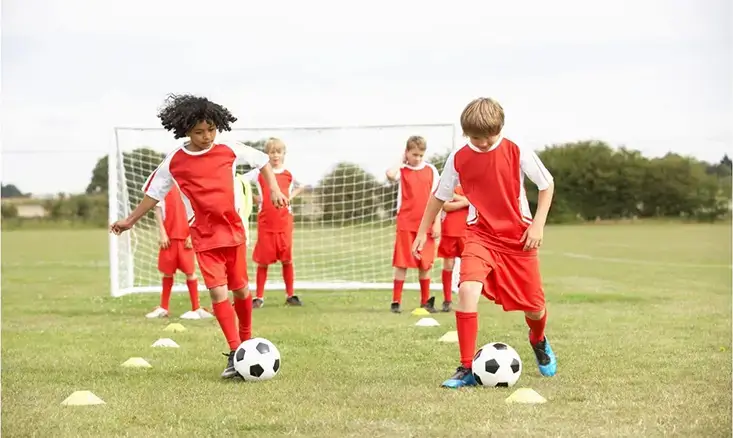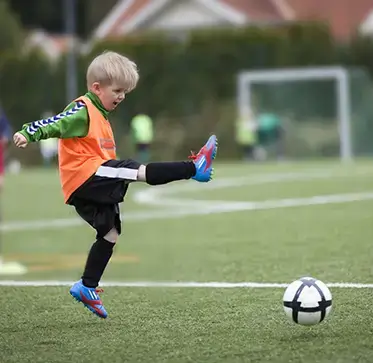CRFC BLOGS
LATEST BLOGS & NEWSLETTERS
18 Effective Youth Soccer Evaluation Drills and Tips
Evaluating youth soccer players accurately during tryouts is essential for building a strong team. A thorough evaluation process helps identify players’ strengths, areas for improvement, and overall fit within the team. This guide presents a comprehensive set of youth soccer evaluation drills and tips to assess players’ technical skills, tactical understanding, and physical fitness.
Youth Soccer Evaluation Criteria
A well-rounded youth soccer evaluation process is important for accurately assessing soccer players. These criteria form the base of a comprehensive soccer evaluation, ensuring that all aspects of a player’s abilities are thoroughly evaluated. The main criteria include the following elements:
Technical Skills
It evaluates a player’s proficiency in dribbling, passing, shooting, and ball control, essential for effective play and maneuverability on the field.
Tactical Understanding
It assesses a player’s ability to make strategic decisions, understand positioning, and demonstrate game awareness, which is crucial for effective team play and situational responses.
Physical Fitness
It measures a player’s stamina, speed, and agility, vital for maintaining high-performance levels throughout the game.
Psychological Attributes
It examines a player’s confidence, teamwork, and attitude, which are important for mental resilience, collaboration, and maintaining a positive team dynamic. For additional practice opportunities, consider enrolling players in our soccer summer camps to further develop these essential skills.
Types of Youth Soccer Evaluation Drills
Youth soccer evaluation drills are designed to assess younger players, focusing on foundational skills and potential. These drills help coaches identify future stars and provide a basis for skill development.
Skill-Specific Youth Soccer Drills
Skill-specific youth soccer drills assess individual technical skills. Focused youth soccer technical drills allow coaches to evaluate specific aspects of a player’s technical abilities. Each drill targets a different skill, clearly showing a player’s strengths and areas for improvement.
Examples
- Dribbling through cones
- Shooting accuracy tests
- Passing drills
Tactical Youth Soccer Drills
Tactical youth soccer drills evaluate players’ understanding of game tactics. Tactical drills are essential for assessing how well players can apply their skills in a game situation. These drills test players’ decision-making, positioning, and ability to work within a team structure.
Examples
- Small-sided games
- Position-specific drills
- Scenario-based exercises.

Youth Soccer Fitness Drills
Youth soccer fitness drills measure players’ physical fitness levels. Physical fitness is a critical component of soccer performance, affecting endurance, speed, and overall effectiveness on the field. Fitness drills provide insights into a player’s stamina, speed, and agility.
Examples
- Endurance runs
- Sprint tests
- Agility drills

Top Youth Soccer Evaluation Drills
Evaluating players using specific drills is an effective way to see their performance under different conditions. Top soccer evaluation drills provide a well-rounded assessment of a player’s abilities.
Passing and Receiving
Objective
Assess accuracy and control.
Description
This youth soccer passing drill involves players making short and long passes. It tests a player’s ability to pass accurately over different distances and control the ball effectively.
Focus Areas
Accuracy, ball control, and precision in passing.
Shooting Practice
Objective
Test shooting skills.
Description
Players take shots from different angles and distances. Coaches look for players who consistently place powerful and accurate shots on goal.
Focus Areas
Power, accuracy, and consistency.
Dribbling Drills
Objective
Evaluate control and speed.
Description
Players dribble through obstacles such as cones. This drill assesses a player’s ability to maintain control of the ball while navigating through a series of cones or markers.
Focus Areas
Ball control, speed, and agility.
Defensive Drills
Objective
Assess defensive capabilities.
Description
This drill involves tackling and marking exercises. Defensive drills help coaches evaluate how well players can prevent attackers from advancing and regain possession of the ball.
Focus Areas
Tackling, marking, and defensive positioning.
Small-Sided Games
Objective
Evaluate game awareness and teamwork.
Description
Players engage in 3v3 or 5v5 games. These games mimic real match conditions, allowing coaches to observe players’ decision-making, positioning, and teamwork.
Focus Areas
Decision-making, positioning, and teamwork.
Conditioning Drills
Objective
Measure endurance and fitness.
Description
This drill includes interval running and sprints. Youth soccer conditioning drills test a player’s stamina and ability to maintain high-performance levels throughout a match.
Focus Areas
Endurance, speed, and stamina.
Heading Drills
Objective
Test heading technique.
Description
Players perform heading accuracy and defensive headers. This drill assesses a player’s ability to head the ball accurately and effectively in both attacking and defensive scenarios.
Focus Areas
Heading accuracy, timing, and defensive heading.
Crossing and Finishing
Objective
Assess crossing ability and finishing.
Description
In this youth soccer crossing drill, players deliver crosses from the wings and finish in the box. Coaches look for players who can deliver accurate crosses and those who can finish scoring opportunities.
Focus Areas
Crossing accuracy, finishing, and timing of runs.
Toe Taps in the Square
Objective
Assess control and speed with the ball.
Description
Players perform continuous toe taps within a marked square. This drill tests a player’s ability to maintain close control of the ball while executing rapid movements. Coaches observe how well players can keep the ball close to their feet and manage quick changes in direction, which is essential for maintaining possession under pressure.
Focus Areas
Rhythm, balance, and ball control.
Shooting Box
Objective
Evaluate shooting accuracy and power.
Description
Players take shots from various positions within a designated box. This drill assesses a player’s ability to shoot accurately and powerfully from different angles and distances. By observing shot placement and consistency, coaches can identify players with strong finishing skills and those who need further development in shooting techniques.
Focus Areas
Accuracy, power, and positioning.
Attack on the Cones
Objective
Test dribbling and attacking skills.
Description
Players dribble through a series of cones, emphasizing quick direction changes. This drill focuses on a player’s agility and ability to move past through tight spaces. Coaches look for players who can maintain close control of the ball while navigating through obstacles quickly and efficiently.
Focus Areas
Dribbling, agility, and speed.
Four Corners
Objective
Evaluate conditioning and tactical awareness.
Description
Players move between four corner markers, practicing passing and movement off the ball. This drill helps assess a player’s fitness and understanding of positioning and movement. It also allows coaches to see how players interact with their teammates and their ability to find and create space on the field.
Focus Areas
Stamina, tactical movements, and passing.
One vs. One in the Circle
Objective
Assess defensive and offensive abilities.
Description
Players engage in one-on-one scenarios within a confined space. This drill is crucial for evaluating individual defending and attacking skills. Coaches observe how well players can defend against an attacker and their creativity and effectiveness in offensive moves.
Focus Areas
Defending, attacking, and spatial awareness.

Tips for Running Effective Soccer Evaluations
Effective soccer evaluations require careful planning, clear communication, and detailed observation. Here are some essential tips:
Organization
Planning
Ensure drills are well-planned and structured. A well-organized tryout helps smoothly transition between drills and keeps players engaged.
Equipment
Prepare all necessary equipment in advance. Having everything ready beforehand ensures that the tryout runs smoothly without unnecessary interruptions.
Communication
Instructions
Provide clear and concise instructions for each drill. Clear communication helps players understand their expectations, leading to more effective evaluations.
Feedback
Offer constructive feedback to players. Feedback helps players understand their strengths and areas for improvement, facilitating development and growth.
Observation
Coaching Team
Use multiple coaches to observe different aspects of players’ performance. A team of coaches can provide a more comprehensive evaluation by focusing on various game elements.
Notes
Keep detailed notes on each player’s strengths and areas for improvement. Detailed notes help make informed decisions about player selections and identify areas for further development.
Evaluation Sheets
Purpose
Track player performance systematically. Using a soccer evaluation form ensures that all aspects of a player’s abilities are recorded and analyzed.
Components
The components of the sheet include technical skills, tactical understanding, physical fitness, and psychological attributes. A comprehensive evaluation sheet helps maintain consistency and objectivity in player assessments.
Drill Variety
Importance
Use diverse drills to evaluate different skill sets. A well-rounded set of drills ensures that players are tested on various aspects of the game.
Key Areas
Key evaluation drills include technical (passing, shooting, dribbling), tactical (positioning, game awareness), physical (stamina, strength), and psychological (confidence, teamwork) drills. This approach helps to identify versatile players and specialists in specific roles.
Recording Performance
Method
A standardized soccer evaluation form ensures consistency and objectivity in player assessments.
Analysis
Detailed notes on each player’s strengths and areas for improvement help make informed decisions about player selections and identify areas for further development.
Conclusion
By incorporating these soccer evaluation drills and tips into your tryouts, you can ensure a thorough and effective evaluation process. This approach helps in building a strong and well-balanced team. Remember, the proper soccer evaluation criteria and techniques are vital in identifying the best talent and potential in your players.
FAQs
What are youth soccer club evaluations/tryouts?
Youth soccer club evaluations or tryouts are sessions designed to assess players’ skills, physical fitness, and overall potential to form similar skill-level teams. These evaluations help coaches make informed decisions about player placements.
What is the youth soccer tryout procedure?
The youth soccer tryout procedure typically involves a series of drills and exercises that test various aspects of a player’s abilities, including technical skills, tactical understanding, physical fitness, and psychological attributes. Players are usually required to participate in these evaluations annually.
How are youth soccer players evaluated during tryouts?
Youth soccer players are assessed based on a set of criteria that includes technical skills (e.g., dribbling, passing, shooting), tactical understanding (e.g., positioning, decision-making), physical fitness (e.g., stamina, speed, agility), and psychological attributes (e.g., confidence, teamwork, attitude).
What types of drills are used in youth soccer evaluations?
Common drills used in youth soccer evaluations include passing and receiving, shooting practice, dribbling through obstacles, defensive drills, small-sided games, conditioning drills, heading drills, and crossing and finishing exercises. Each drill focuses on specific skills and attributes.
How should coaches communicate evaluation results to parents and players?
Effective communication with parents and players involves providing clear, constructive feedback. Coaches should explain the evaluation criteria, discuss each player’s strengths and areas for improvement, and outline the next steps in their development.

Did you find this useful?


